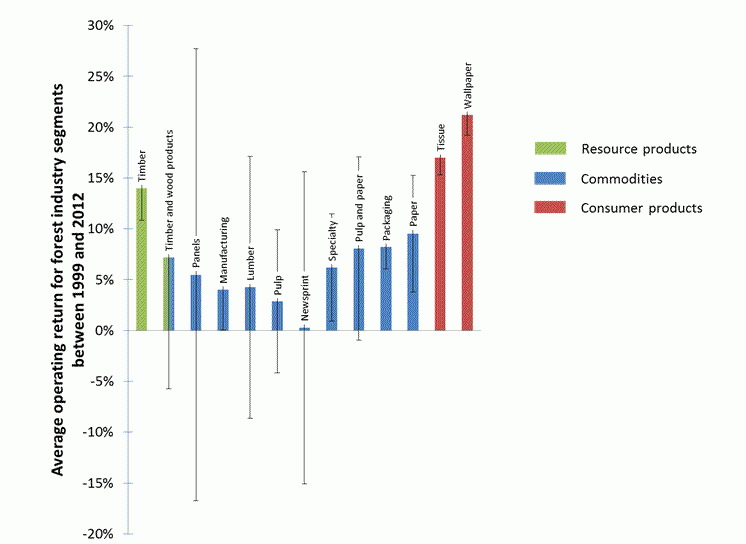Selective Cuttings
Operating margins of timber and consumer products – and everything in between
August 26, 2013
Commodity chain theory suggests that there are three general types of products within the forest product manufacturing chain, each occupying its own well-defined space within the market. First, there is the resource, in terms of (private) forest land and logs being sold into the market. Second, there are commodities, such as NBSK pulp, newsprint, and lumber. And third, there are consumer goods such as tissues and wallpaper.
Commodity producers are generally thought of as price takers—their products are fungible with their competitors’, and they have little control over input fibre costs. This tends to squeeze their operating margins, and force them to adopt cost cutting strategies to increase profits. On the other side, consumer goods can be branded and differentiated from competing goods, and successful companies can increase margins by building consumer preferences and raising prices. Firms owning the resource—in this case logs—are often able to capture all the value associated with commodity production, leaving only just enough value for commodity manufacturers to generate enough ROCE to continue operation.
We wanted to compare performance across these three groups of products, so we used the financial results of publically traded forest companies operating between 1999 and 2012 to calculate average operating margins (see graph below). The data do not cover privately-owned companies. “Specialty” includes products manufactured through branching off of the pulp and paper manufacturing process, such as specialty paper, specialty packaging, specialty cellulose, chemicals etc. Because some companies do not separate their pulp production from their integrated paper production, a “pulp and paper” category has also been included. It is intuitive that it is situated midway between the separate pulp and paper categories. Similarly “manufacturing” and “timber and wood products” find their way between “timber” and “lumber”/“panels”.
High operating margins segments (i.e. consistently above 10%) include packaging, tissue and wallpaper but also timber. Paper, specialty and wood products regularly yielded above 5% margins over the past 13 years. While 13 years would normally nicely cover one or two business cycles, the U.S. housing crash has been so deep, and so extended, that the lumber and panels performance in this data undoubtedly reflect a poorer performance than might be expected moving forward. Newsprint has yielded the lowest margins over the past 13 years.
Forest sector operating returns along the forest product manufacturing chain
Note: lines indicate standard deviation.
The first thing to notice is that the highest returns are found at the two extremes of the forest value chain. Owning timberlands or selling raw timber gives good returns, as does producing consumer products. However, the production of commodities shows much lower returns.
The second point is that the operating margins of commodities have much higher standard deviations associated with them. These forest sector commodities are highly cyclical, and the operating margins vary widely from year to year.
The results seem to support our thoughts on where value is captured in the forest value chain. Of course, these results are subject to the many structural and cyclical trends that characterize our industry, so it is not only the macro-level story here that is in play. But it is nice to see that here, at least, economic theory seems to be showing up well in the data.

